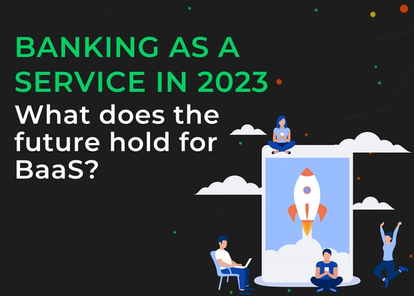Banking as a Service in 2023: What does the future hold for BaaS?

Today, an increasing number of financial institutions, non-Bank financial firms and retailers are bringing an array of innovative financial services to market with help of Banking-as-a-Service (BaaS).
With the current market considering traditional banking models as outdated and costly, an increasing amount of companies are now adopting BaaS solutions to fill their banking requirements and set themselves up for growth. In practice, this means that a mass of non-financial businesses are bringing novel solutions to market to retain their customers – everything from novel payment solutions to standard debit cards to market. Meanwhile, financial services providers are bolstering their pre-existing offerings and finally stepping into the 21st Century.
With the BaaS market predicted to reach $11.34 billion by 2030, the future certainly looks bright. Looking a little closer to home, what does the fintech crystal ball hold for 2023 and beyond? Our experts have pulled together three top trends that businesses looking to leverage BaaS opportunities are exploring.
1. Embedded finance will reach new heights
Many non-financial organisations today already know the value of embedded finance, which seamlessly integrates services like Buy-Now-Pay-Later into customer journeys. The benefit of doing so is clear: businesses can create new revenue streams and boost customer satisfaction, resulting in a strong customer retention strategy.
With the market expected to exceed $7 trillion over the next 10 years, embedded finance's worth will reach double the combined value of the world’s top 30 banks today
With this in mind, we predict that embedded finance will continue its ascent in 2023, with more focus on B2B eCommerce, which is quickly becoming a hotly contested battleground. Expect to see more startups entering the space, offering niche financial products to businesses like BNPL for businesses, merchant financing, and trade credit insurance.
2. Will real-time payments finally be within reach?
One pain point that has plagued businesses for many years is cross-border payments, which tend to be slow, costly and confusing. While the topic of real-time payments is nothing new and banking initiatives like the UK’s Faster Payment System help make this reality, many businesses aren’t using instant payments for all their transactions.
As real-time payments are yet to be the norm, smaller companies are particularly vulnerable and may suffer from cash flow issues as a result of delayed payments. Sometimes, these issues can be so significant that businesses find their entire organisation under threat.
Thankfully, according to new research 26% of mid-size organisations plan to jump on the real-time payment bandwagon in 2023. With simpler payment journeys ahead, we expect real-time transactions to become cheaper and more prevalent in the near future, with many businesses looking to BaaS providers to handle their payments, rather than relying on legacy banks who may not be up to the task.
3. The rise of Open Banking
As of January 2022, over 5 million people used services powered by Open Banking. In 2023, we expect uptake to reach unprecedented levels, with people relying on open banking technology for all aspects of their financial lives – from finding tailored savings suggestions, to personalised loans and credit options.
Statistics from the UK Government stand up to support this prediction. It’s currently estimated that the majority (60%) of the UK population will be using Open Banking payments by September 2023, and we believe savers have nothing to lose and everything to gain from using these services.
As advancements in Open Banking, real-time payments and embedded finance ramp up, businesses must ensure that they’re ahead of the fintech curve to avoid falling behind their competitors.





